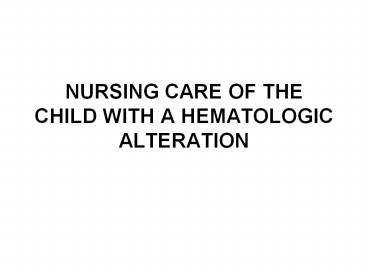NURSING CARE OF THE CHILD WITH A HEMATOLOGIC ALTERATION - PowerPoint PPT Presentation
1 / 8
Title:
NURSING CARE OF THE CHILD WITH A HEMATOLOGIC ALTERATION
Description:
NURSING CARE OF THE CHILD WITH A HEMATOLOGIC ALTERATION Disorders of the red blood cells RBCs are pale and smaller Iron Deficiency Anemia Most common anemia caused by ... – PowerPoint PPT presentation
Number of Views:67
Avg rating:3.0/5.0
Title: NURSING CARE OF THE CHILD WITH A HEMATOLOGIC ALTERATION
1
NURSING CARE OF THE CHILD WITH A HEMATOLOGIC
ALTERATION
2
Disorders of the red blood cells
- RBCs are pale and smaller
- Iron Deficiency Anemia
- Most common anemia caused by improper iron intake
- Giving cows milk instead of baby formula is main
culprit during the first year - Adolescent girls are at risk because of
menstruation - Causes poor growth, poor test scores later
- Treatment
- Ferrous Sulfate for two months
- Restoration takes three months
- Retic count will increase 7-10 days after
starting therapy - Education
- Give between meals for better absorption
- Vit C increases absorption
- Milk and tea with meals reduces absorption
3
Disorders of the red blood cells
- Macrocytic Anemias
- RBCs are larger than usual
- Megaloblastic Anemias
- Folic Acid Deficiency
- Causes in children
- Low birth weight
- Intake of powdered or goats milk
- Defective absorption
- S/S
- Poor weight gain
- Chronic diarrhea
- Management
- Folic acid
4
- Megaloblastic Anemias
- Pernicious Anemia
- Causes
- Lack of intrinsic factor, must be deficient 2
years for symptoms to develop - Management
- Vitamin B12 1mg daily x 1-2 weeks, then once
weekly until HH are normal, then monthly for
life - Hemolytic Anemias
- Sickle Cell Disease
- Autosomal recessive, sickle shaped RBCs
- Asymptomatic in infancy prior to 5-6 months
- Clinical course characterized by episodic crises
- Management
- Pain relief, hydration, oxygenation
5
DISORDERS OF BLOOD COAGULATION
- Hemophilias
- Hemophilia A (Factor VIII deficiency)
- Sex-linked recessive
- S/S
- Soft tissue bleeding and bleeding into joints
- Management
- Administration of factor VIII
- Von Willebrands disease
- Autosomal dominant
- Factor VIII defect, inability of platelets to
aggregate, and inability of blood vessels to
constrict
6
- Hemophilias continued
- S/S
- Bleeding, esp, from m.m.
- Management
- Factor VIII replenishment or DDAVP
- Christmas disease (Hemophilia B, Factor IX
deficiency) - Sex-linked recessive
- Treated with factor IX
- Hemophilia C (Factor XI deficiency)
- Autosomal recessive
- Symptoms are mild when compared to other types
7
Immune Thrombocytopenia Purpura
- Acquired disorder characterized by low platelet
count - Etiology
- Can be drug-induced or follows a febrile illness
- S/S
- Bruising and petechiae
- Therapeutic Management
- Usually self-limiting but may require steroids,
IV immunoglobulin, or splenectomy - Nursing considerations
- No IM injections
- No rectal temps
- Avoid meds that kill/interfere with platelet
production
8
Aplastic Anemia
- Bone marrow ceases production of all cells
- S/S
- Petechiae, pallor, fatigue, bruising
- Etiology
- Congenital, exposure to drugs/chemicals,
idiopathic - Therapeutic Management
- Transfusions, stem cell transplant, chemotherapy
- Nursing Considerations
- Low-platelet considerations plus reverse
isolation

